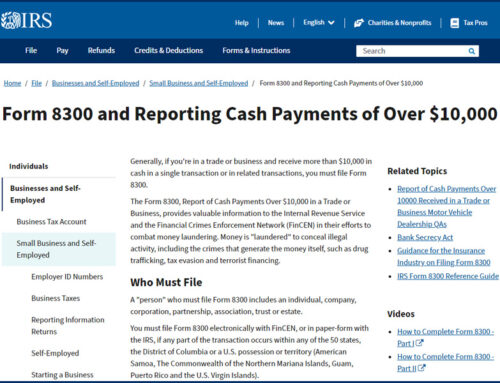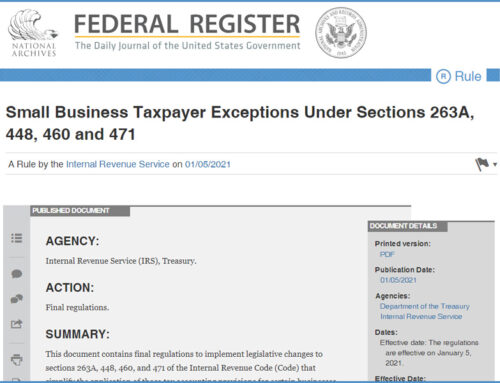The following are some strategies we should consider for reducing your business’s taxes for 2023.
The key changes in the tax laws for 2023 are a result of two laws enacted in 2022, the Inflation Reduction Act (2022 IRA) and the SECURE 2.0 Act. The 2022 IRA expanded the clean energy credits available to businesses, while the SECURE 2.0 Act made various changes to encourage taxpayers to save for retirement.
Qualified Business Income Deduction
If you are conducting your business as a sole proprietorship, a partner in a partnership, a member in an LLC taxed as a partnership, or as a shareholder in an S corporation, the qualified business income (QBI) deduction can significantly help reduce taxable income. The QBI deduction allows eligible taxpayers to deduct up to 20 percent of their QBI, plus 20 percent of qualified real estate investment trust dividends and qualified publicly traded partnership income. A W-2 wage limitation amount may apply to limit the amount of the deduction. The W-2 wage limitation amount must be calculated for taxpayers with a taxable income that exceeds a statutorily-defined amount (i.e., the threshold amount). For any tax year beginning in 2023, the threshold amount is $364,200 for married filing joint returns and $182,100 for all other returns.
Since the QBI deduction reduces taxable income and is not used in computing adjusted gross income, it does not affect limitations based on adjusted gross income, such as the medical expense deduction or the calculation of social security income that is includible in income. However, the QBI deduction does not apply to a “specified service trade or business,” which is defined as any trade or business involving the performance of services in the fields of health, law, accounting, actuarial science, performing arts, consulting, athletics, financial services, brokerage services, including investing and investment management, trading, or dealing in securities, partnership interests, or commodities, and any trade or business where the principal asset of such trade or business is the reputation or skill of one or more of its employees. Engineering and architecture services are specifically excluded from the definition of a specified service trade or business.
Rental Real Estate
If you have any rental real estate activities, it’s important to determine if the activity will be considered a passive activity by the IRS. Generally, losses from passive activities are only deductible against passive activity income. However, a deduction of up to $25,000 ($12,500 if married filing separately) may be allowed against nonpassive income to the extent you actively participate in the rental real estate activities. This deduction is subject to a phaseout for individuals with modified adjusted gross income above $100,000 (or $50,000 if married filing separately). Additionally, you may be eligible for a qualified business income deduction if certain criteria are met, such as the rental activity qualifying as a Section 162 trade or business.
Substantiation of Vehicle-Related Deductions
In audits, the IRS tends to focus on deductions taken for vehicle expenses. If not properly substantiated, such deductions are disallowed. Thus, if vehicles are used in any part of your business or business-related activities, your tax records with respect to each vehicle should include the following:
(1) the amount of each separate expense with respect to the vehicle (e.g., the cost of purchase or lease, the cost of repairs and maintenance, etc.);
(2) the amount of mileage for each business or investment use and the total miles for the tax period;
(3) the date of the expenditure; and
(4) the business purpose for the expenditure.
The IRS will consider the following as adequate substantiation for such expenses: (1) records such as a notebook, diary, log, statement of expense, or trip sheets; and (2) documentary evidence such as receipts, canceled checks, bills, or similar evidence.
It’s important to note that records are considered adequate to substantiate the element of a vehicle expense only if they are prepared or maintained in such a manner that each recording of an element of the expense is made at or near the time the expense is incurred.
Pass-Thru Entity Considerations
If you are operating a business through a pass-thru entity such as a partnership or S corporation, your basis in the entity must be high enough to allow for any loss deduction if you have one for the year. In such a situation, we should consider the options available for increasing your basis in such an entity.
If you are an S corporation shareholder, it’s important to ensure that you and other shareholders involved in running the business are paid an amount that is commensurate with the work being done. The IRS scrutinizes S corporations that distribute profits instead of paying compensation subject to employment taxes. Failing to pay arm’s length salaries can lead to tax deficiencies, interest, and penalties. The key to establishing reasonable compensation is showing that the compensation paid for the type of work an owner-employee does for the S corporation is similar to what other entities would pay for similar work. An S corporation needs to adequately document the factors that support the salary an S corporation owner is being paid.
Also, because there are stringent requirements for who may be an S corporation shareholder if the number of shareholders have changed or increased during the year, we should review the residency or citizenship status of the S corporation’s shareholders and S corporation stock beneficiaries (including contingent and residuary beneficiaries).
Energy-Efficient Commercial Buildings Deduction
If your business owns a commercial building, a deduction is available for an amount equal to the cost of “energy efficient commercial building property” placed in service during the tax year. EECBP includes property installed as part of the building’s interior lighting systems; heating, cooling, ventilation, and hot water (HVAC) systems; or the building envelope that is certified as being installed as part of a plan to reduce the total energy and power costs for these systems. An alternative deduction is also available for energy-efficient building retrofit property installed as part of a qualified retrofit plan that is expected to reduce the building’s energy use intensity upon completion of the retrofit by 25 percent or more.
The 2022 IRA expanded this deduction by increasing the maximum deduction and changing the maximum from a lifetime cap to a 3-year cap. For property placed in service in 2023 and after, the amount of the deduction equals the lesser of (1) the cost of the energy-efficient commercial building property or (2) the energy savings per square foot. The maximum deduction increases to 5 times the savings per square foot amount if local prevailing wages are paid and apprenticeship requirements are met.
Clean Vehicle Credits
The 2022 IRA expanded the tax new clean vehicle credit, which is available to individuals but can also be claimed by businesses that purchase and place in service a new clean vehicle. The law also introduced the qualified commercial vehicle credit for businesses that purchase and place in service a commercial clean vehicle.
New Clean Vehicle Credit. The new clean vehicle credit is a credit of up to $7,500 for the year a taxpayer places in service a new clean vehicle, final assembly of which occurs in North America. The calculation of the new clean vehicle credit amount depends on when the taxpayer takes delivery of the vehicle. For vehicles delivered on or after January 1, 2023 and before April 18, 2023, the credit amount equals a base amount of $2,500 and is increased by the amount of propulsion energy produced by the battery. For vehicles delivered on or after April 18, 2023, the credit amount equals $3,750 for vehicles meeting a critical minerals requirement plus $3,750 for vehicles meeting a battery component requirement.
This credit is not available to taxpayers whose adjusted gross income (AGI) for the year is over $300,000 (married filing jointly), $225,000 (head of household), and $150,000 (single). Price limits (i.e., MSRP limitations) also apply depending on the type of vehicle ($80,000 for vans, SUVs, and pickup trucks; $55,000 for other vehicles).
If a partnership or an S corporation places a new clean vehicle in service, and the new clean vehicle credit is claimed by individuals who are partners of the partnership or shareholders of the S corporation, the AGI thresholds apply to those partners or shareholders. In addition, if a new clean vehicle is used both for personal and business use, and the business use of the vehicle is less than 50 percent of the total use of the vehicle, the credit must be apportioned and treated as a general business credit corresponding to the percentage of the business use.
The Department of Energy provides a list at FuelEconomy.gov of qualifying vehicles with the credit amount for each vehicle and the applicable MSRP limitation.
Qualified Commercial Clean Vehicles Credit. The 2022 IRA also introduced a new credit for qualified commercial electric vehicles placed into service and used in a trade or business by the taxpayer after 2022. The amount of credit is the lesser of (1) 15 percent of the taxpayer’s basis in the vehicle (30 percent in the case of a vehicle not powered by a gasoline or diesel engine) or (2) the “incremental cost” of the vehicle. The credit is limited to $7,500 for a vehicle weighing less than 14,000 pounds and up to $40,000 for all other vehicles.
A “qualified commercial clean vehicle” is defined as any vehicle that is (1) used in the taxpayer’s trade or business or for the production of income, (2) acquired for use or lease by the taxpayer and not for resale, (3) treated as a motor vehicle under the Clean Air Act and is (i) manufactured primarily for use on public roads or (ii) mobile machinery, and (4) propelled to a significant extent by an electric motor which draws electricity from a rechargeable battery. The “incremental cost” of the vehicle generally means the excess of the purchase price over the price of a comparable vehicle powered solely by a gasoline or diesel internal combustion engine. Under a safe harbor rule provided by the IRS, the incremental cost will not limit the available credit amount for street vehicles that weigh less than 14,000 pounds and are placed in service in calendar year 2023.
Energy Investment Tax Credit
The energy investment tax credit (ITC) was also extended by the 2022 IRA and could reduce your business’s federal tax liability by a percentage of the cost of a solar system installed during the tax year. Solar systems placed in service in 2022 or later, and that began construction before 2023, are eligible for a 30 percent ITC, or a production tax credit based on a kilowatt-hour formula if they meet certain prevailing wage and apprenticeship requirements or are under 1 megawatt in size.
Research and Development Deductions and Credits
Finally, the provision allowing a deduction for research and development (R&D) expenses expired at the end of 2021. Such expenditures must now be amortized over five years. However, under the 2022 IRA, businesses that engage in certain types of research may qualify for an income tax credit based on their qualified research expenses. The credit is calculated as the amount of qualified research expenditures above a base amount meant to represent the amount of research expenditures in the absence of the credit. Because some small businesses may not have a large enough income tax liability to take advantage of their research credit, the law allows that small business (i.e., a business with less than $5 million in gross receipts and that is under five years old) to apply up to $250,000 of the research credit toward its social security payroll tax liability. The 2022 IRA expanded the amount available for the credit from $250,000 to $500,000 for tax years beginning after 2022.
There’s a slim chance that the R&D expensing provision may be restored retroactively for 2023. There have been ongoing discussions between Republicans and Democrats about a potential tax deal regarding the reinstatement of immediate R&D expensing in exchange for an enhanced child tax credit similar to the enhanced child tax credit that applied for 2021. Because it is unclear what, if any, tax legislation may be passed before the end of the year, our year-end planning will have to be based on existing law.
As you can see, there is much to consider before we prepare your 2023 business tax return and calculate any estimated tax payments that might be due in 2024. Let me know if you would like to discuss any provisions before the end of the year. Call me at your convenience at (818) 225-8022.


